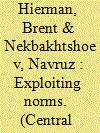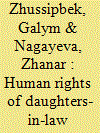|
|
|
Sort Order |
|
|
|
Items / Page
|
|
|
|
|
|
|
| Srl | Item |
| 1 |
ID:
178469


|
|
|
|
|
| Summary/Abstract |
Uzbekistan and Kazakhstan have new leaders for the first time since 1989: Shavkat Mirziyoyev as Uzbek president and Kassym-Jomart Tokayev as Kazakh president. This article uses a theoretical framework based on the literatures of leadership change and political succession while overlaying this literature with the type of economic policies followed by each former leader to analyse the political and economic transitions in these countries. Mirziyoyev has legitimized his authority, even though he was not part of the elite, through reforms designed to help the people (as Karimov had envisioned in the ‘Uzbek way’). In contrast, Nazarbayev’s policies were centred around the state as a facilitator of economic development, a problem for citizens in an economic downturn. While Tokayev transitioned through a formal electoral process, his was a ‘managed’ designation, with the charismatic leader still in a formal position of power, leaving Tokayev without a separate base of legitimacy.
|
|
|
|
|
|
|
|
|
|
|
|
|
|
|
|
| 2 |
ID:
178473


|
|
|
|
|
| Summary/Abstract |
This paper discusses the place-renaming policies in the recent two decades in Armenia. By elaborating on the legal and administrative framework for place-renaming in the country and through the analysis of more than 27,000 geographical names and their renaming practices, the paper focuses on the politics of space/place in Armenia in the context of a nation-state-building. By considering discourses, actors and institutions involved in place-renaming, the paper puts its results into the wider context of nationalism and nation-state-building. With a focus on the notion of raison d'état as a practice of governmentality, the abstract space of the nation-state conceived by experts and nationalist discourse on autochthony, the paper elaborates on the production of nation-state-space in Armenia. The contradictory aspects of place-renaming policies and the relations of exclusion and domination (re)produced in the process of conceiving of the nation-state-space in this country are discussed as well.
|
|
|
|
|
|
|
|
|
|
|
|
|
|
|
|
| 3 |
ID:
178470


|
|
|
|
|
| Summary/Abstract |
This article aims to provide a more complete and dynamic account of the legal framework that underpins religious regulation in Central Asia from independence in 1991 through 2018, focusing on Kyrgyzstan, Tajikistan and Uzbekistan. In contrast to existing approaches that rely on a few key laws, high-profile events or secondary sources, our analysis includes the entire body of legal documents available in government digital legal data repositories. We find that although these three Central Asian states’ approach to religious regulation has become more repressive over time, they have done so at very different paces and to very different degrees. While they have all increasingly restricted religious belief and practice that falls outside state-approved interpretations of Islam, the turn towards criminalization was much quicker and more blatant in Uzbekistan than in Kyrgyzstan and Tajikistan, and has been much more absolute in Uzbekistan and Tajikistan relative to Kyrgyzstan.
|
|
|
|
|
|
|
|
|
|
|
|
|
|
|
|
| 4 |
ID:
178468


|
|
|
|
|
| Summary/Abstract |
This article advances a straightforward argument: a complete analysis of land reform processes in Central Asia needs to account for gender dynamics. More explicitly, it argues that alongside the feminization of agriculture, customary gender norms restricting female economic opportunities and property acquisition represent a structural advantage for local elites interested in hindering or delaying the process of farm individualization in Tajikistan. After overviewing the gap between female legal rights to agricultural land and the actualization of these rights in four Central Asian states (Kazakhstan, Kyrgyzstan Tajikistan and Uzbekistan) the article narrows its focus to Tajikistan. After regression analyses reveal that gendered information gaps are insufficient to account for gaps in the registration of farmland, the study presents qualitative data examining the relationship between female-headed households and the slow pace of agrarian change in Tajikistan.
|
|
|
|
|
|
|
|
|
|
|
|
|
|
|
|
| 5 |
ID:
178471


|
|
|
|
|
| Summary/Abstract |
The familial position and social status of daughters-in-law (kelins) in ‘traditional’ Central Asian families can be characterized as low, subservient and marginalized. By adopting normative human rights discourse, this paper argues that it is an example of the relativist challenge of cultural authenticity towards the universality of human rights, specifically women’s human rights. By using participant observation which can also be qualified as experiential research, serial in-depth and informal interviews, and an analysis of posts published in social media, the forces driving the persistence of a relativist approach to kelins’ human rights such as retraditionalization, the revival of conservative Islam, an unawareness of the human rights and the patterns of authority-subordination are explored. Through a conceptual framework combining Iris Young’s concept of the ‘five faces of oppression’ and the notion of ‘harmful traditional practices’, elaborated by international human rights documents, the study conceptualizes the family position and social status of the kelins as one of structural oppression or systemic injustice, created and legitimized by informal, harmful traditional norms and practices.
|
|
|
|
|
|
|
|
|
|
|
|
|
|
|
|
| 6 |
ID:
178467


|
|
|
|
|
| Summary/Abstract |
In Uzbekistan, the pure monopoly enjoyed by the state-owned car manufacturer UzAvtosanoat has resulted in domestic car shortages and long waiting periods. This article examines the politico-economic mechanisms behind these shortages, as well as the ways in which the latter affect – and are curtailed by – aspirant car owners. It argues that shortages are a consequence of the Karimov-era policy of ‘self-reliance’ and in particular of the goal of attaining a positive trade balance by means of export prioritization and import substitution. The article juxtaposes the workings of Uzbekistan’s car industry and market with the Soviet era and suggests that they lead to the consolidation of a post-socialist shortage economy. Inevitably, similarly to their Soviet-era counterparts, local consumers face often insurmountable obstacles in their attempts to purchase a car and are exposed to access inequalities, debt, corruption, speculation, and the rent-seeking practices of local patronage networks.
|
|
|
|
|
|
|
|
|
|
|
|
|
|
|
|
| 7 |
ID:
178472


|
|
|
|
|
| Summary/Abstract |
In 2013, international news headlines started referencing Georgian Tarkhan Batirashvili, or Omar al-Shishani, as a rising star among foreign fighters in the Islamic State of Iraq and Syria (ISIS). At the time, it was puzzling why a Georgian Kist would fight for ISIS. However, following al-Shishani, around 200 other residents of Georgia’s Pankisi Gorge travelled to Syria and Iraq. The trend raised numerous questions about radicalization in this country with very limited experience with terrorism. This article examines why so many Pankisi Kists departed for Syria and Iraq. Specifically, we analyse the impact of the neighbouring insurgencies in the North Caucasus and examine how the Chechen conflicts shaped the emergence of radicalism in Georgia’s Pankisi Gorge. The article traces how the movement of individuals, equipment and ideas to and from Chechnya impacted the Muslim identity of the local population in Pankisi.
|
|
|
|
|
|
|
|
|
|
|
|
|
|
|
|
|
|
|
|
|